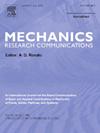使用科学机器学习的拉伸膜结构集成设计,包括起皱考虑
IF 2.3
4区 工程技术
Q3 MECHANICS
引用次数: 0
摘要
拉伸膜结构(TMS)由于其美观、轻便和覆盖大面积的能力而非常受欢迎。然而,TMS的设计涉及两个具有计算挑战性的步骤:(a)找形-找到在给定预应力和边界条件下的初始平衡形状;(b)载荷分析-确定获得的形状是否能够抵抗设计载荷。此外,薄膜起皱现象给框架的载荷分析带来了更大的困难。传统的基于网格的分析框架存在病态刚度矩阵和由于起皱而引起的收敛问题。因此,在本研究中,通过将负载分析问题作为直接能量最小化问题并使用准牛顿优化器进行求解,提出了一种无网格负载分析框架。还提出了在无网格方法中考虑起皱的修正势能公式。在功能连接理论(TFC)的帮助下,采用梯度增强物理信息神经网络(gPINN)进行分析,确保了动力学上可接受的场变量,而不需要额外的损失函数来强制执行基本边界条件。该分析框架消除了计算显式刚度矩阵和惩罚参数的要求。此外,还引入了矢量化实现,使所提出的方法在计算上可行。最后,提出了一种用于框架式和索式TMS无缝设计和分析的集成顺序寻形和载荷分析框架。进行了广泛的数值案例研究,以测试所提出框架的有效性。与传统的基于网格的方法相比,本文还指出了该方法的计算效率。本文章由计算机程序翻译,如有差异,请以英文原文为准。
Integrated design of tensile membrane structures using scientific machine learning including wrinkling considerations
Tensile membrane structures (TMS) are extremely popular these days owing to their aesthetic appeal, lightweight and their ability to cover large expansive areas. However, the design of TMS involves two computationally challenging steps: (a) form-finding — to find the initial equilibrium shape subjected to the given prestress and boundary conditions and (b) Load analysis — to determine whether the obtained form can resist design loads. Furthermore, the membrane wrinkling phenomena causes even more difficulties in load analysis frameworks. Traditional mesh-based analysis frameworks suffer from ill-conditioned stiffness matrix and convergence issues that can arise due to wrinkling. Hence, in this study a mesh-less framework for load analysis is proposed by posing the load analysis problem as a direct energy minimization problem and solving it using a Quasi Newton optimizer. Modified potential energy formulations for wrinkling considerations incorporated in the mesh-free approach are also proposed. The analysis is performed by employing gradient-enhanced physics-informed neural networks (gPINN) aided by the theory of functional connections (TFC) ensuring kinetically admissible field variables without the requirement of an additional loss function for enforcing the essential boundary conditions. The analysis framework eliminates the requirement of calculation of an explicit stiffness matrix and the penalty parameter as well. Additionally, a vectorized implementation is incorporated, making the proposed approach computationally feasible. Finally, an integrated sequential form-finding and load analysis framework for seamless design and analysis of frame-supported and cable-supported TMS is proposed. Extensive numerical case studies are performed to test the efficacy of the proposed framework. The computational efficiency of the proposed method in comparison to a traditional mesh-based method is also noted.
求助全文
通过发布文献求助,成功后即可免费获取论文全文。
去求助
来源期刊
CiteScore
4.10
自引率
4.20%
发文量
114
审稿时长
9 months
期刊介绍:
Mechanics Research Communications publishes, as rapidly as possible, peer-reviewed manuscripts of high standards but restricted length. It aims to provide:
• a fast means of communication
• an exchange of ideas among workers in mechanics
• an effective method of bringing new results quickly to the public
• an informal vehicle for the discussion
• of ideas that may still be in the formative stages
The field of Mechanics will be understood to encompass the behavior of continua, fluids, solids, particles and their mixtures. Submissions must contain a strong, novel contribution to the field of mechanics, and ideally should be focused on current issues in the field involving theoretical, experimental and/or applied research, preferably within the broad expertise encompassed by the Board of Associate Editors. Deviations from these areas should be discussed in advance with the Editor-in-Chief.

 求助内容:
求助内容: 应助结果提醒方式:
应助结果提醒方式:


